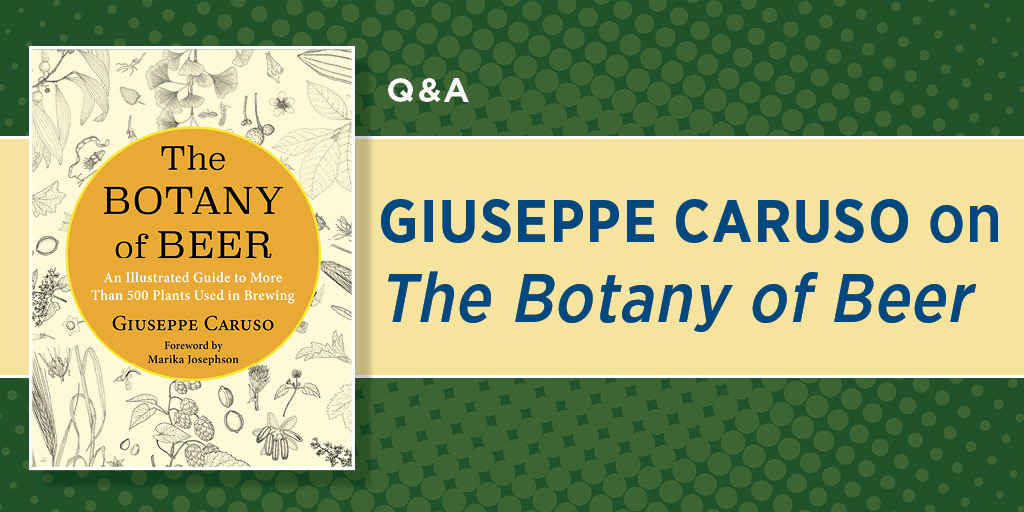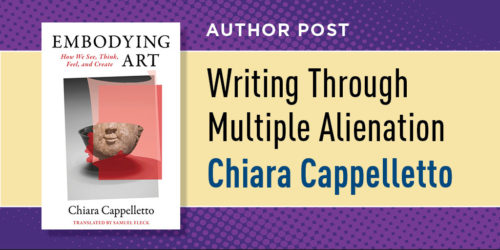Q&A: Giuseppe Caruso on The Botany of Beer

Pour a pint, and read about its incredible plant origins. Giuseppe Caruso’s The Botany of Beer: An Illustrated Guide to More Than 500 Plants Used in Brewing provides a lovely look into the raw materials that can spice up your brew—providing a true cask of knowledge for all beer-brewing enthusiasts. But how did this detailed catalog of more than 500 plants used in brewing come to be? In this delightful interview, Caruso opens up about what led him to write this must-have reference and how his specific point of view as a botanist can bring a plant world of wonder to your favorite beer.
Q: Good morning, Dr. Caruso. I keep turning this beautiful book over in my hands like a happy child. It is truly a magnificent, full-bodied, thick, solid object: hard cover, 640 pages, 500 described plant species, 500 ink botanical drawings. How was this project born?
Dr. Caruso: The Botany of Beer was born, as would be appropriate for any project concerning beer, at the counter of a pub. Sipping, a few years ago, a fragrant American Pale Ale, a brewer proposed me, as a botanist, to give some lessons to aspiring homebrewers on the plants used in beer making. The subsequent attempt to list plant species used for this purpose, in addition to barley and hops, produced a disappointing result. We did not go beyond a dozen species. It seemed like an ephemeral and undemanding project to complete. Never have first impressions proved more deceptive. As soon as I started researching the topic, the list began to grow out of all proportion, until there were hundreds of brewing plants listed.
Q: A volume of this magnitude and with so many contents (and hundreds of botanical drawings!) will surely have had a long and tiring gestation?
Dr. Caruso: In life, in addition to study and hard work, you also need a bit of luck. In this specific case, luck consisted in running into Jennifer Crewe. The director of Columbia University Press immediately embraced the project, addressing the difficulties that inevitably arise while transforming a manuscript into a product ready for bookstore shelves. Everything else is four years of study, hard writing work, and endless sessions at the drawing board.
Q: And now let’s go to the contents. How is this book a new thing compared to other similar books?
Dr. Caruso: To tell the truth, as far as we have been able to ascertain, there are no books analogous to this one. There is no book that systematically dealt with all the vegetable ingredients used worldwide in beer brewing. Of course, a lot of books on beer exist. However, most of them are focused on brewing techniques. A few deal with beer styles, and some are even monographic volumes on a single style. Other books explore tasting techniques and service. Very few deal with the raw materials, and these are invariably focused, even in monographic form, on the four main ingredients: barley, hops, yeast, and water. Is it ever possible to be a brewer, a job very similar to that of a chef, without knowing the features of all the available ingredients?
Q: Dr. Caruso, you are a beer sommelier and a beer expert, but you are above all a botanist, a plant expert. Why, in your opinion, was a botanist the best choice to write the missing book on beer ingredients?
Dr. Caruso: The professional publishing landscape of the beer sector is dominated by a pool of recognized beer experts; however, in the vast majority of cases, these do not have a specific background in the field of plant biology. In order to look at plants not as simple ingredients but as living organisms with a complex anatomical-morphological organization, products of a long evolutionary and biogeographical history, adapted to a specific ecology and with a certain chemical composition, it was necessary that this book be written by a professional botanist. Botany is a rigorous, ordered, systematic science. The stringent rules of botanical nomenclature have made it possible to attribute the correct scientific name to each of the 500 species treated and to gather around that name all kinds of information useful for the work of the brewer: parts of the plant used in beer brewing, chemical composition, possible toxicity, beer styles in which a certain species has been used, and examples of beers brewed with the contribution of that specific plant.
Q: So will we also find specific botanical notions in the book?
Dr. Caruso: Sure, but not as a sterile scientific exercise. The scientific information is always at the service of those who brew beer. If a brewer decides to enhance a beer by adding plant species that grow in their territory, they obviously need to know the biogeographical origin of the ingredients. The description of each species includes special sections about its natural geographic distribution, the territory in which it is currently grown (which does not necessarily overlap with the previous section), and its ecology. But the book’s ambition goes even further. The detailed morphological description (following the scheme commonly applied in botany books: root, stem, leaf, flower, fruit, seed) and the botanical iconography serve to allow the brewer to recognize each plant species described in the book. Does the brewer become a bit a botanist or, at least, a botanophile? Why not? It has been like this for millennia, in all places that can boast an ancient tradition of beer production. The brewer has always been the main actor behind the supply—and therefore the recognition—of the ingredients of their beers. And now this is also starting to happen even in places without any previous brewing tradition. The shrewdest brewers have come to understand that connecting with the ingredients growing in their own territory, in particular with the native flora, is the best way to undertake a productive and commercial path based on originality, personality, and recognizability.
Q: Who inspired you to write this book?
Dr. Caruso: In order to feel confident enough on the topic to write this book I read mounds of magazines, books, and scientific articles, but I also consulted countless blogs and websites. I even took tasting courses to improve my understanding of the brewing universe. It was a path of personal enrichment, even before it was an editorial project. Therefore, the authors to whom The Botany of Beer owes something would be numerous: Stan Hieronymus, for sure, whose book Brewing Local, among the many he wrote, was certainly very influential for me. And then Sam Calagione, owner of Dogfish Head, an authentic giant of the craft world and unsurpassed in finding wonderful brewing balances among uncommon ingredients. However, the best affinity with the spirit I have tried to instill in this book, I believe has to be found at the Scratch Brewing Company, in Ava, Illinois. It is no coincidence that the two owners, Aaron Kleidon and Marika Josephson, are, respectively, an expert forager and a recognized brewster. Just as it is no coincidence that Marika wrote the preface of The Botany of Beer. And then Pascal Baudar, who, with his book The Wildcrafting Brewer, opened a new era of selective breeding of invasive alien plants. This practice allows the free supply of raw materials for brewing and, at the same time, has a positive impact on the environment. What more could you want?
Q: Whom is the book aimed primarily at?
Dr. Caruso: The book is aimed at a general public of conscious consumers but also administrators with responsibilities for the environment, agriculture, and alcohol production and trading. Then there is a potential amateur audience made up of beer lovers, botanophiles, and, above all, homebrewers. Finally, the book is aimed at a large audience of people who deal with beer for purely professional reasons, covering very different sectors. Aren’t farmers, agronomists, botanists, and foragers the professionals whose work flows into the production of beer, influencing it from the very first steps? Not to mention the professional brewers, from the small craft plant to the large industrial plant. And then there are those who professionally deal with the supply chain (wholesalers of raw materials and beer, commercial representatives, etc.), as well as those who deal with the final distribution (bar owners and bartenders, waiters, cooks, beer sommeliers, etc.). Last but not least, those who deal with information about the beer industry (journalists, food and beverage bloggers) and, perhaps more importantly, teachers and students who deal with topics such as agriculture, beer brewing, and catering.
Q: Thanks for your time, Dr. Caruso. I confess: I did not know what to expect from this meeting, but I must say you were very convincing and your answers certainly intrigued me. Any concluding remarks?
Dr. Caruso: Thanks to you for the opportunity to make my work known. Whoever writes a book obviously wants it to be read. In this specific case, however, the hope goes far beyond the simplistic yet legitimate desire for mere personal success. In fact, reading this book introduces a whole new range of information that had hitherto been precluded from the world of beer. We cannot therefore discount the possibility that, over time, The Botany of Beer can help the beer sector to find again a fuller and more sustainable identity, uniquely and recognizably associated with the individual territories where beer is brewed. If the book were to succeed in this aim, certainly as ambitious as it is difficult, then it would have made sense to invest so much energy in its editing. In any case, The Botany of Beer will be a technical textbook that amateur and professional brewers will consult more or less assiduously in search of new inspiration for their beer productions. And even this, to be honest, would not exactly be a trivial outcome.








